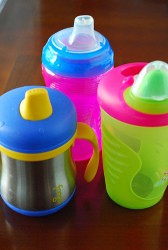 Oregon is looking to ban BPA from baby bottles, sippy cups, baby formula cans, and reusable sports water bottles. Washington did a similar ban last year—minus a ban on formula cans. And Oregon is proposing an interesting add-on to its proposed rules: requiring manufacturers to label cans as containing BPA.
Oregon is looking to ban BPA from baby bottles, sippy cups, baby formula cans, and reusable sports water bottles. Washington did a similar ban last year—minus a ban on formula cans. And Oregon is proposing an interesting add-on to its proposed rules: requiring manufacturers to label cans as containing BPA.
Then shoppers get to decide if they want a can of peaches lined with a known endocrine disruptor for their toddler’s lunch, or if they will opt instead for a non-BPA can, or maybe frozen or fresh peaches.
The Oregon Environmental Council is drumming up support for the legislation—numbered HB 3258—on this BPA-Free Oregon Facebook page.
Transparency in ingredients and packaging is a great tool for moving us toward safer consumer goods, and one that manufacturers are hard pressed to argue against. If they stand behind the safety of their products and the chemicals they’re using, they’ve got nothing to hide. If BPA and my other favorite family of hormone disruptors, phthalates, are so fantastic and necessary, the chemical industry and manufacturers should tell me they’re in their products—and specifically which chemicals—heads held high.
Of course it would be nicer if these chemicals were not present in the first place so, as shoppers, we weren’t obligated to memorize the name of a couple dozen nasties to avoid while cruising the grocery aisles. But at least the information would be available, particularly if you want to reduce exposure to those who are most vulnerable to BPA and other hormone-mimicking chemicals’ effects: namely babies, children, and pregnant women.
So far, nine states have banned BPA in baby bottles, and Connecticut and Vermont have additionally banned it from infant-formula cans and baby-food jars. The Washington ban roles out in two phases:
Beginning on July 1, 2011, no one can make or sell a “bottle, cup, or other container, except a metal can, that contains bisphenol A if that container is designed or intended to be filled with any liquid, food, or beverage primarily for consumption” for children age three and under.
Beginning on July 1, 2012, no one can make or sell reusable sports bottles containing BPA.
Interestingly, the Washington ban excludes metal cans, even if used for baby food. Oregon attempted a BPA ban last year, but the measure failed, largely over the inclusion of baby-food containers. Why the concern over metal cans? Bisphenol A, which is used to line tin cans to make the food last longer and to improve freshness, can leach out of the lining and into the food, as was reported in Consumer Reports in 2009, and the Environmental Working Group offers a seemingly exhaustive list of research articles on the topic. Environmental Working Group did its own BPA-tin can study in 2007 and found:
For 1 in 10 cans of all food tested, and 1 in 3 cans of infant formula, a single serving contained enough BPA to expose a woman or infant to BPA levels more than 200 times the government’s traditional safe level of exposure for industrial chemicals.
This article from Reuters does a great job on the tin-can threat and why BPA is used in the epoxy linings, as well as the less-toxic alternatives that are available.
Canada has been cracking down on the use of BPA, though it’s been slow to take bold action since banning the toxic chemical in baby bottles in 2008. And still more US states are working on legislation to ban BPA in bottles and sippy cups, and in some cases to additionally ban it in infant formula cans and cash-register receipt paper.
A division of the US National Institutes of Health ruled in 2008 that there was reason to be concerned about BPA harming human health—namely people’s behavior, brain, and prostate gland—and particularly when it came to exposure to fetuses, babies, and children. Other research links early exposure to the chemical with obesity and reproductive problems later in life.
There’s no word yet on when Oregon lawmakers will have a hearing or vote on the legislation, and I’m interested to see how they respond to the labeling requirement. Under Proposition 65 in California, businesses are required to notify Californians when products contain significant amounts of any of the 800 chemicals the state has deemed toxic.
Nearly a year ago California’s Office of Environmental Health Hazard Assessment published a notice requesting public comments on a proposal to add BPA to their list of dangerous chemicals. The comment period ended last May and there’s no news on what’s happened to the plan.
Sippy cup photo from Flickr user SliceOfChic used under the Creative Commons license.

Comments are closed.